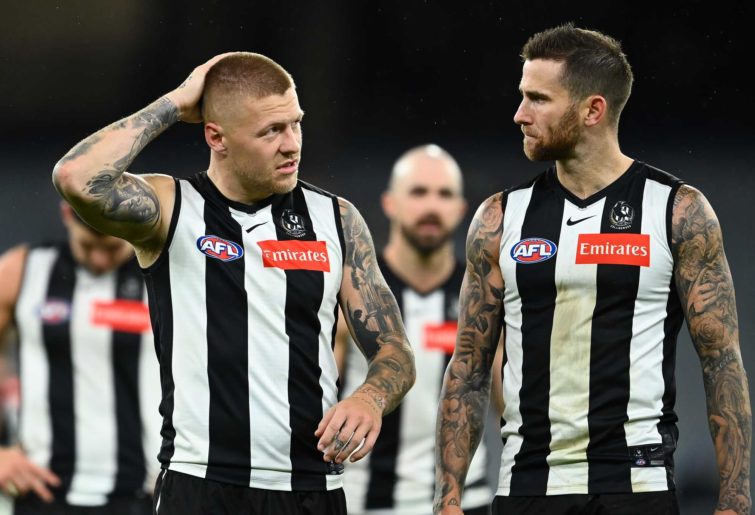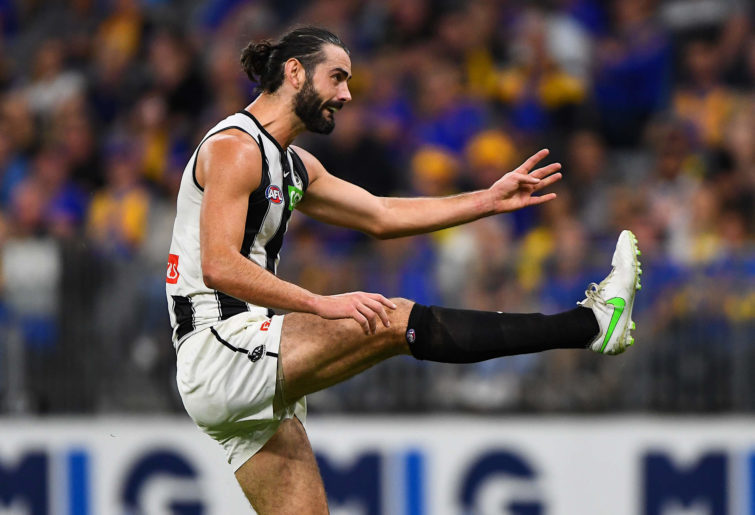I got into so many arguments in the off-season about where Collingwood stood.
I was repeatedly assured we were better off without Adam Treloar and Tom Phillips. They were labelled terrible ball users, so how could we not improve without them in the side?
I was told we could cover for Jaidyn Stephenson. People threw hypothetical teams at me, citing that players such as Brayden Sier and Nathan Murphy and that any of the swathes of draftees Collingwood picked up would thrive given their opportunity.
The club knew what it was doing. That was flung at me over and over and over.
The club knew what it was doing. I was negative. I had it wrong. I was being pessimistic.
And here we are in Collingwoodland, 2-7.
Do I see any admission that these people got it wrong? Do I see any recognition that the club has mucked this up? Do I see any alarm whatsoever?
Nope.

(Photo by Quinn Rooney/Getty Images)
Now, it would be one thing if that alarm were lacking because we were dealing with unflappable insightful personalities. But we’re not. We’re dealing with people who can see no wrong, who believe only in the best imaginable. I can’t even label them optimists. They’re fatalists. Fatalists who believe Collingwood are apparently infallible. Even when they’re not.
While Treloar and Phillips could occasionally burn the ball, I often wondered if that wasn’t exaggerated because of Collingwood’s system.
Look at Collingwood’s skill level now. It’s deplorable. Am I meant to believe that Collingwood has a collection of players on their list who don’t know how to use the ball? That guys like Scott Pendlebury and Steele Sidebottom suddenly have lost all their kicking skills?
Or are players constantly put under pressure, resulting in panicked disposals? Is there poor structural movement resulting in kicking to congestion? Is there an overcomplication in ball movement that has players second and even triple-guessing every disposal?
These are all things I see regularly. Every player will occasionally burn the ball, and some are worse than others, but I believe Collingwood’s game plan – and the way it’s systematically broken down over the last three years – has exacerbated those figures.
If you follow the stats, both Adam Treloar and Tom Phillips have travelled at about 70 per cent disposal efficiency at their new clubs – that’s a far cry from people who asserted they burned the ball more often than not. I’d hazard a guess that Treloar is currently in All Australian calculations.
Jaidyn Stephenson remains a mystery. Too many people have used a poor 2020 as the personification of who he is. Granted, Stephenson had a terrible 2020. He looked timid and unsure. Yet he still ended up second on Collingwood’s goal kicking.
He won the Rising Star in 2018. Yes, not every Rising Star winner goes on to have a brilliant career, but up until his suspension Stephenson’s 2019 was tracking better than his debut year. This is not opinion; it’s in the stats.
Is he a flawless player? No. Were there problems in 2020? Certainly – but any number of other players also struggled with hub life. Was Stephenson irredeemable? Well, for some reason Collingwood seemed to believe so.
If it was purely a salary cap squeeze, there are numerous older players I would’ve chopped before a potential ten-year prospect. And even if Stephenson was problematic, recognising the upside I would’ve taken that gamble on persevering with him rather than getting back virtually nothing. If Stephenson wasn’t worth a gamble, it’s a failure of people of the club not to identify that prior to drafting, and a failure of the people in charge who are meant to nurture and develop him.
Stephenson’s form at North Melbourne has proven he can play. I still read similar complaints about him that were expressed last year. These criticisms are unfair given his statistical return in a side that is developing and, up until the last fortnight, was regularly belted.
Ironically, Collingwood lack run and carry, and these three players – these players they claimed they could cover – would’ve helped them. Treloar (being played as Luke Beveridge is playing him), Phillips (if he was returned to the wing rather than played as a defensive forward, as occurred in 2020), and Stephenson (if he was promoted into the midfield, which surely must’ve been the eventual goal) are all players eminently qualified to carry the ball, break lines and provide linkages.
Nathan Murphy is rated highly internally. Collingwood valued him equally with Jaidyn Stephenson in the draft, and if Stephenson wasn’t available at Pick 6, they would’ve gone with Murphy. Instead Collingwood were able to get him with Pick 39.
Murphy played a couple of games in 2018 and then struggled with injuries for two years. This year he’s looked capable, but he’s still a kid who came into the season with just two games under his belt and two seasons since his last AFL appearance.

(Photo by Quinn Rooney/Getty Images)
Brayden Sier had a wonderful 2018 – a big midfielder who could stand up in tackles and fire out beautifully weighted handballs. He played a handful of games in 2019 and 2020 and looked for whatever reason a shadow of himself.
These two have shown all the qualities of genuine AFL players, but I’m unsure why anybody thought Murphy (with two games under his belt going into 2021) and Sier (with 21 games going into 2021) could immediately and consistently replace Treloar (173 games), Phillips (89 games) or Stephenson (54 games).
That’s just not how AFL works.
Unless the kid is supremely talented and hits the ground running – like Chris Judd, Matt Rowell or, dare I say it, Jaidyn Stephenson – they’ll show the occasional highlight, play the occasional good game but take two to four seasons to really find themselves at this level.
Collingwood has debuted six players this year as well as continued to pump games into guys like Murphy, Mark Keane, Will Kelly, Tyler, Callum Brown, Darcy Cameron, Isaac Quaynor, John Noble et cetera.
Given this list profile, I’m unsure how anybody thought all these young players would simply be plug and play and replace not only those players who were traded but also the ones who retired. More than that, some claimed these replacements would improve Collingwood.
Then we have to deal with the on-field devolution we’re been seeing since 2019. It’s the same list of issues: poor skills, poor decision-making, a lack of connectivity, broken tackles, indecisive ball movement, vulnerability on the counterattack, horrible forward entries and too many players getting too little of the ball.
And that’s before we take scoring into account. On Saturday we saw Collingwood look amazingly purposeful and kick four goals in the first quarter but then just one more for the game. This is not a new problem.

(Photo by Daniel Carson/AFL Photos via Getty Images)
In 2020 they kicked one goal in three quarters against Geelong in the semi-final. Against Essendon in Round 5 Collingwood kicked three goals in the third quarter and then did not score a goal for the next two quarters. Against St Kilda, Collingwood kicked ten goals in the first half and just two goals for the second half. In Round 2 against Richmond they kicked four goals in the first quarter, one in the second and none in the second half.
Go back to 2019 and they kicked three goals in the first quarter against GWS in the preliminary final and then didn’t score another goal for the next two quarters. Against Geelong in the qualifying final they didn’t score a goal in the second half.
This is excluding all the times they kicked low returns.
The symptoms of the on-field breakdown were there; they were available for everybody to diagnose. But most ignored them, like that pack-a-day smoker who’s beginning to wheeze and cough but doesn’t admit that maybe, just maybe, his habit is to blame.
Instead of acknowledging there were issues to be addressed, many somehow expected that the people who weren’t currently able to remedy them would somehow remedy them. Why? If you were repeatedly seeing a doctor for an ailment that they couldn’t fix, you’d go to a different doctor.
Sydney Swans have always been a dour, defensive side under not only John Longmire but also his predecessor, Paul Roos. This year they have brought in Don Pyke to assist with their attacking side. Melbourne brought in Mark Williams.
Collingwood stuck with the same people and for some reason expected they could fix these problems or that somehow bringing all these young players into the team would immediately improve them.
Some might cite injuries. Well, injuries are a part of AFL football, particularly at Collingwood. For Collingwood to have been competitive this year they would’ve effectively needed their best 15 to stay on the park the whole year – an unrealistic expectation.
All the evidence was there that Collingwood would have a poor 2021 – well, if you wanted to see it.
Some don’t. They still don’t. And this is the thing that astonishes me: there were people who saw all this coming, who ranted about it, and yet they were condemned as negative. Given what they foresaw has come to pass, you have to reassess them. They’re not negative. They’re realistic. What they said would happen is happening. That’s reality rather than negativity or pessimism.
And the people who thought it would all be fine, that there was nothing to see here, that condemned everybody else as overreacting, have seamlessly changed narrative without any acknowledgement about just how wrong they got it.
Now it’s all about what Collingwood’s missing, about the rebuild – even though the club themselves suggested they were rejuvenating the list and expected to play finals this year. It’s about maintaining the status quo because – well, I don’t know.
If you’re not going to acknowledge problems, if you’re not going to identify the issues when they’re glaring at you, if you’re just going to requalify your stance when that reality is battering you over and over, then nothing will ever change, because in your world no truth is ever faced.































































































